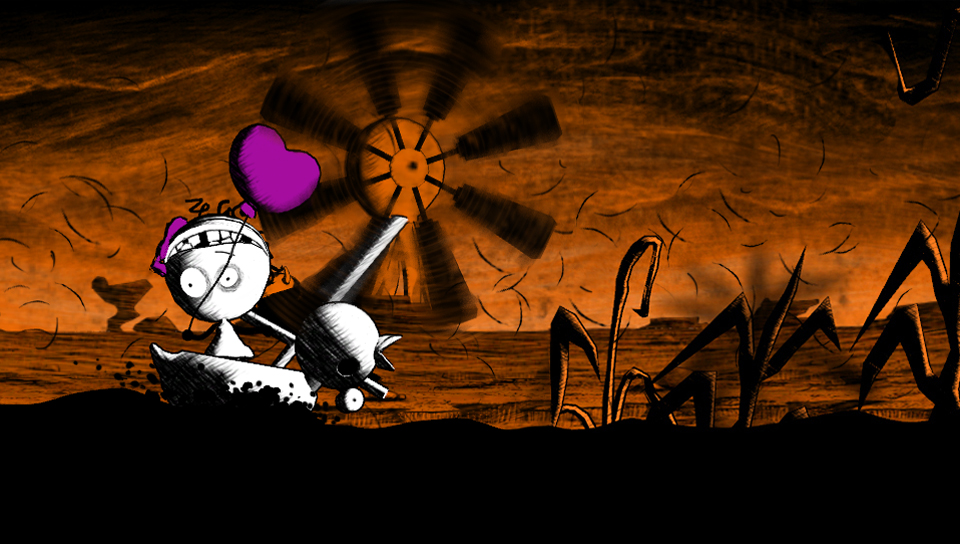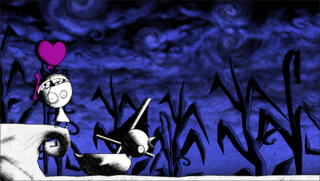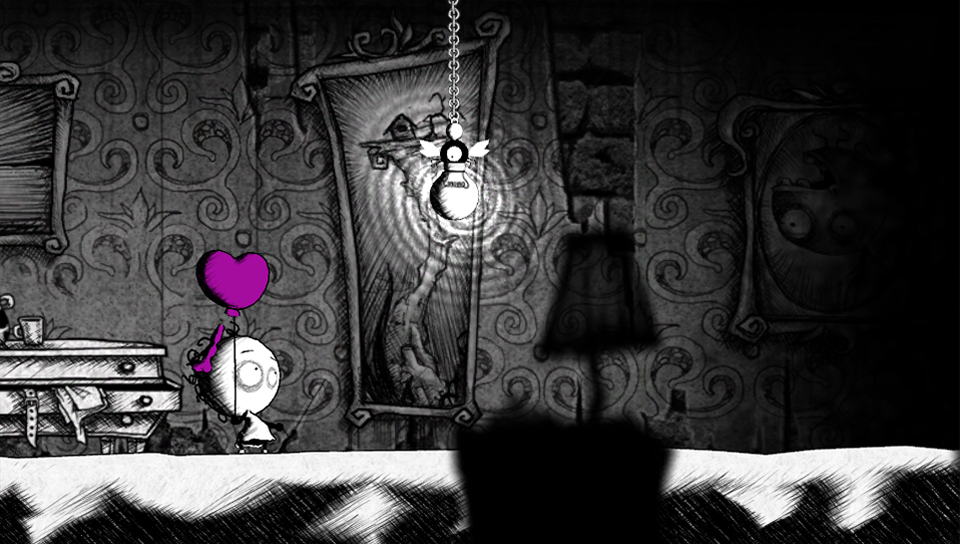Murasaki Baby is a nightmare framed by your greatest childhood frights. The scenery is ghoulish, with mangled trees drooping overhead as you guide a defenseless child through dark storms and even darker caverns. The denizens she meets along the way are ripped right out of a Jhonen Vasquez comic, sporting noses for faces and gaping mouths on their foreheads. It's no world I'd care to travel through, but the grotesquely creative environments are still somehow enchanting. The beautiful, hand-sketched landscapes are perfectly paired with a spine-chilling soundtrack that accentuates the child's loneliness. It packs an auditory punch, but how you control the game weakens the experience by distracting you from Murasaki Baby's alluring look.
It's unclear who the scared little girl is or why she was abandoned, but you feel responsible for her fate as soon as the game starts. Beyond her affectionate coos and bone-rattling shrieks, the only discernible noises she offers are cries for her mother that she squeezes through her mangled teeth. You can't pick her up and carry her, so instead you place a finger on the touchscreen to grab the frightened child's hand. Dragging her almost-elastic arm too far forward causes her to stumble and eventually fall to the dirt, so you must gently guide her forward as you search for her missing mother.

Just about every movement is controlled through the Vita's front and back screens. Along with the hand-holding, you use another finger to control the position of a heart-shaped balloon to which the child is clinging. This magenta memento, which matches the bow decorating the child's wiry hair, can be popped with a single prick. It's her life force, so you have to pay close attention to its position when flying safety pins or wooly one-eyed spiders fight to puncture it.
All other actions are controlled through quick swipes on the rear touchpad. Popping other characters' balloons gives you the ability to change your environment with the flick of a finger, painting the backdrops with vivid reds, greens, or blues. Shifting the palette might give you the power to summon thunderstorms, channel electricity, turn your balloon into stone, or even shrink the child down in order to overcome more advanced sequences. Tapping the back of your Vita when the shading is orange creates gusts of wind that push a dilapidated sailboat across a gully, while jabbing a giant in the yellow background spurs him to shake the earth and demolish specific obstacles in your way.
The beautiful, hand-sketched landscapes are perfectly paired with a spine-chilling soundtrack that accentuates the child's loneliness.
There is a medley of abilities you need to play with in order to solve each puzzle, most of which call for expert timing. Although you won't likely feel challenged by the basic riddles, it's fun to mix and match puzzle-solving techniques on the fly to see what works, and it can be rewarding to master the often-precise timing. Additionally, the visual flourishes stemming from these abilities--like watching your balloon crystallize as you freeze the environment around you--make this already striking package even more potent.
The presentation can be intoxicating, and that's why the control scheme is so frustrating. Having your finger on the screen during the majority of the game means that there are parts of the display you simply can't see. You can position your hand so that it doesn't command too much real estate, but once you're asked to worry about the safety of both the child and her balloon, your vision becomes far too obstructed. The experience can quickly become a disjointed game of digital Twister, forcing you to position both your hands and the Vita in an obtrusive manner.

Murasaki Baby's biggest sin is that it's just not all that fun to control, and having your fingers cover corners of the screen is detrimental to both how you play and see the game. I found myself less focused on the dynamic presentation and more concerned with making sure the different pieces on screen were in the right place at the right time. The Vita's multitouch display responds elegantly to every touch, so every time the balloon popped, it actually felt like it was my fault and not a result of broken mechanics. And for the most part, holding the character's hand throughout the many terrifying sights and sounds makes you feel more connected with her every move. It's just a shame that it comes at the expense of fully enjoying everything this gothic world has to offer.
The mechanical failings are clearest when you're allowed to let go of the child's hand and briefly use the analog sticks to get from place to place. A particular level has you control a stroller of sorts that takes away any need to poke or prod either of the two touch screens. Here, I took in every piece of geometry. I appreciated the heavy character shading, the luminous hues of the scenery, the forbidding setting, and the ghostly audio mix. Murasaki Baby is a brilliant-looking game, but the moments of unobstructed vision are too few and far between.

Controlling Murasaki Baby can be tiresome, and your hands are too often covering the dazzling, shadowy vistas that provide such a distinctive personality. Still, this often-touching adventure is too great an audio-visual treat to discount. You learn to care for the lost little girl whose arching tears graze the edges of her misplaced mouth, and the multitude of imaginative abilities that make use of the Vita's inputs are interesting enough to keep your attention. Despite my distaste for all the hand-holding, Murasaki Baby's mesmerizing art style and strong emotional backbone left me too invested to let go.